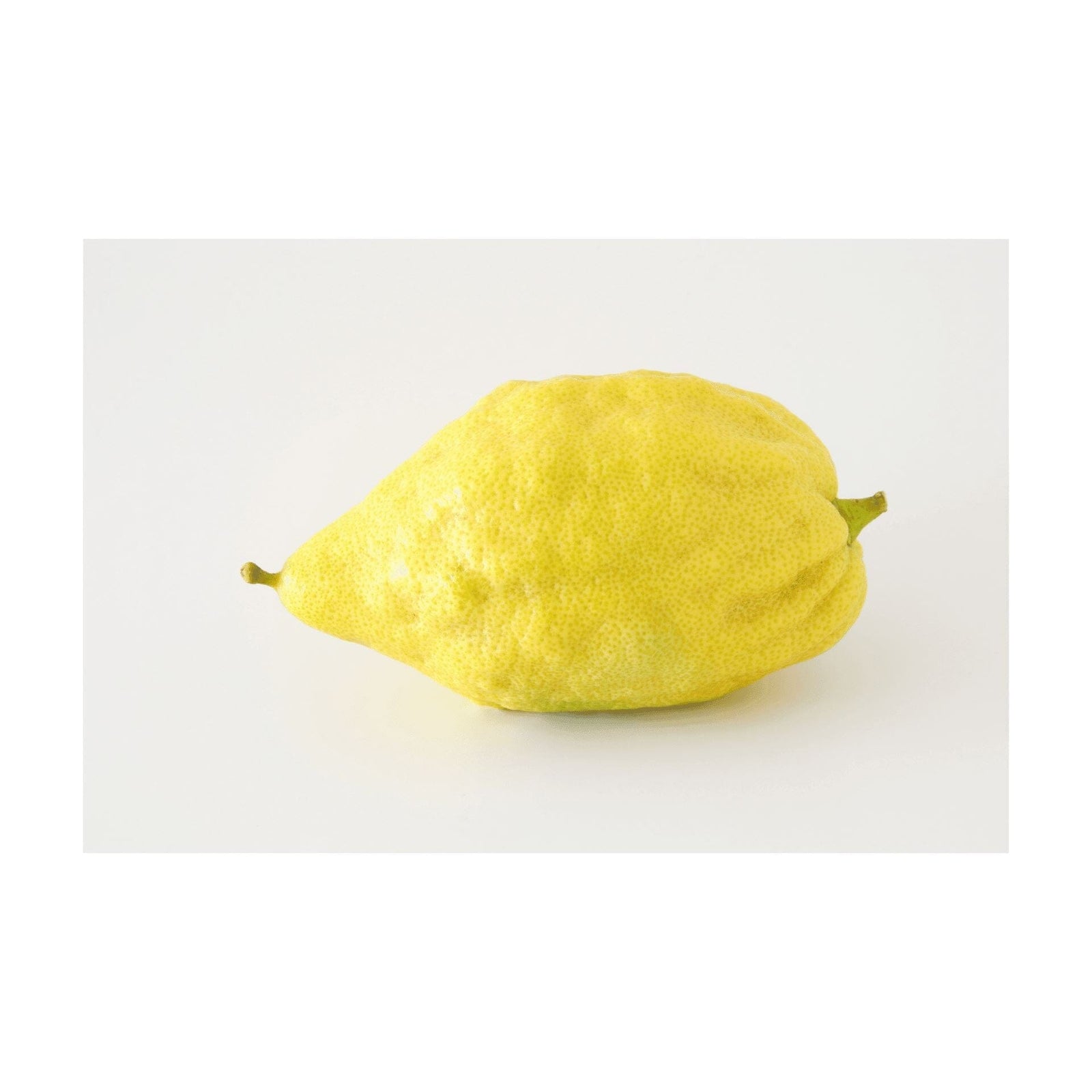The origin of the etrog
The etrog (also called the lemon of the Torah) is a citrus fruit native to the Middle East. More specifically, it is cultivated primarily in Israel, Morocco, and Persia. For centuries, the etrog has played an important role in Jewish tradition, especially during the Feast of Tabernacles.
The etrog fruit is oval-elongated and has a rough, yellow skin. Its flesh is juicy and aromatic, with a slightly bitter taste. Many people describe the scent of the etrog as unique and almost mystical.
The meaning of the etrog in Jewish tradition
For Jews all over the world, the etrog is a very special symbol. During the Feast of Tabernacles, one of the most important Jewish holidays, the etrog is tied together with three other plants (palm fronds, myrtle, and willow branches) to form a bouquet, the lulav.
This bouquet has a deep symbolic meaning: The four plants represent different character traits and values that are highly valued in Judaism. The etrog, with its distinctive shape and unique fragrance, represents wisdom and integrity.
During the Feast of Tabernacles, the lulav (bunch of ostrich feathers) is waved daily and held in the direction of the four cardinal directions. This symbolically expresses the Jewish people's connection with God and creation.
The etrog in the kitchen
In addition to its spiritual significance, the etrog is also a true treasure in the kitchen. The pulp can be used in a variety of ways—from baking to jams and liqueurs.
Candied etrog shells are particularly popular as decorations or snacks. The shells are first soaked in sugar water to preserve them and reduce their bitterness. They are then rolled in sugar and dried to create a delicious delicacy.
The etrog also has a variety of uses in traditional Jewish cuisine. For example, it is used in dishes such as Moroccan charoset, a sweet paste made from fruits, nuts, and spices.
The search for the perfect etrog
For many Jews, finding the perfect etrog for the Feast of Tabernacles is an annual tradition. Not every etrog fruit meets the strict criteria.
The etrog must have a flawless, smooth bowl, free of dents or blemishes. The shape is also crucial – it should be as symmetrical and slightly curved as possible. Furthermore, the etrog must exude an intense fragrance and have a bitter yet aromatic flavor.
The search for the perfect etrog can be quite a challenge. Many Jews make annual pilgrimages to special etrog markets to find the best fruit for the upcoming holiday. Some even travel to Israel to buy directly from the grower.
The etrog - a gift from nature
The etrog is truly a fascinating fruit. Not only does it play an important role in Jewish tradition, it is also a true delight for all the senses. Its unique scent, distinctive shape, and aromatic flavor make the etrog something very special.
Whether you're Jewish or not, the etrog is worth discovering. Perhaps you'll even find a way to incorporate this mysterious citrus fruit into your everyday life. Whether as an ingredient in your favorite dishes or simply to enjoy.
The etrog is a gift from nature that reminds us to appreciate the beauty and diversity of our world. So let yourself be enchanted by this special fruit and discover its very own story!
Etrog jam
Ingredients (for approx. 4 glasses of 250 ml each)
- 3 etrogs
- 1 lemon (for extra juice and flavor)
- 1.5 kg sugar (gelling sugar 1:1 or 2:1, depending on the desired consistency)
- 1.5 liters of water
- 1 vanilla pod
- 1 pinch of salt
preparation
1. Preparation of the etrogs
-
Wash :
- Rinse the etrogs thoroughly under running water to remove any dirt and residue from the bowl.
-
Peeling :
- Using a vegetable peeler or a sharp knife, thinly grate the thick outer skin of the etrog. Be careful to remove only the yellow layer and largely avoid the bitter white part (albedo).
-
Prepare the pulp :
- Halve the peeled etrogs lengthwise and scoop out the fibrous inside and the seeds with a spoon.
- Roughly chop the pulp and place it in a large bowl.
- Squeeze the juice from the lemon and add it to the etrog fruit to prevent oxidation and add extra freshness.
2. Soaking and cooking
-
Soaking :
- Place the prepared etrog pulp and lemon juice into a large pot.
- Add water and let the mixture soak overnight or for at least 6 hours at room temperature. This helps release the flavors and sweeten the jam evenly.
-
Cook :
- The next day, bring the mixture to a boil.
- Cut the vanilla pod lengthwise, scrape out the seeds and add them to the pot along with the pod (optional).
- Add a pinch of salt.
- Simmer gently over medium heat for about 1 to 1.5 hours, until the etrog leaves are soft and the liquid has reduced significantly. Stir occasionally to prevent burning.
-
Add sugar :
- Gradually stir in the sugar until it is completely dissolved.
- Continue simmering the jam until it reaches a thick, set consistency. This may take another 20–30 minutes. Test the setting: Place a small spoonful of jam onto a cold plate; if it sets, the jam is ready.
3. Filling and storage
-
Filling :
- Pour the hot jam into sterilized jars. This ensures a longer shelf life and prevents the growth of germs.
- Immediately close the jars tightly and turn them upside down for a few minutes to create a vacuum.
-
Let cool :
- Allow the jam to cool completely.
- Turn the glasses over and then put them back in the correct position.
-
Storage :
- Store in a cool, dark place.
- Once opened, store in the refrigerator and consume within a few weeks.
Serving suggestions
- On bread or rolls : Enjoy the aromatic etrog jam as a special spread.
- With cheese platters : Goes well with various cheeses, especially goat cheese or blue cheese.
- In desserts : Use the jam as a filling for cakes, tarts or as a topping for ice cream and puddings.
- As a glaze : Spread pastries or donuts with the warm jam for a sweet and sour note.
Tip : For an extra flavor, add spices like a cinnamon stick or star anise during cooking. Remove the spices before bottling for a clear jam.
Etrog jam is a wonderful way to enjoy the unique flavors of this special citrus fruit. With its intense aroma and balanced sweetness, it's a delicious addition to many dishes and a perfect treat for special occasions. Enjoy !

